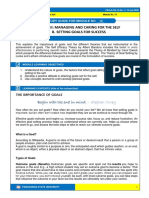10_Handout_1A(3)
10_Handout_1A(3)
Uploaded by
faithlia502Copyright:
Available Formats
10_Handout_1A(3)
10_Handout_1A(3)
Uploaded by
faithlia502Copyright
Available Formats
Share this document
Did you find this document useful?
Is this content inappropriate?
Copyright:
Available Formats
10_Handout_1A(3)
10_Handout_1A(3)
Uploaded by
faithlia502Copyright:
Available Formats
GE2405
SETTING GOALS FOR SUCCESS
Setting goals is a crucial step in achieving personal and academic success. By defining what we want to
accomplish, we can create a roadmap that guides our actions. This module explores the importance of
goals, key theories related to goal setting, and practical strategies for creating clear and achievable goals.
The Importance of Goals
Goals give direction to our efforts and help us stay focused on what truly matters. Sharing your goals
with others can create a support system that encourages you to stay committed. By recognizing and
celebrating milestones along the way, you can build self-confidence and maintain your motivation.
SMART Goals
To ensure your goals are effective, consider using the SMART criteria. This framework helps you create
clear and realistic goals that can lead to success.
1. Specific – Your goal should be clear. Ask yourself:
o What exactly do I want to achieve?
o Why is this goal important?
o Who needs to be involved?
o Where will this take place?
Example: "I will improve my math grade by 10% by the end of the semester."
2. Measurable – Your goal should include clear criteria to monitor your progress and determine when
the goal has been achieved. Ask yourself:
o How will I track my progress?
o What indicators will show when the goal is achieved?
o What is the timeframe for achieving this goal?
Example: "I will track my progress through test scores and assignments.”
3. Achievable – Your goal should be attainable. Consider your resources and constraints. Ask yourself:
o How can I reach this goal?
o Is this goal realistic?
o Do I have the resources and skills needed to achieve it?
o What obstacles might I face, and how can I overcome them?
Example: "I will study for an hour daily to achieve my desired grade."
4. Relevant – Ensure that your goal is meaningful to you. It should align with your broader life
objectives. Ask yourself:
o Is this goal truly worthwhile?
o How does this goal align with my broader objectives?
o Is this the right time to pursue this goal?
Example: "Improving my grade is important for my academic success."
10 Handout 1A *Property of STI
Page 1 of 3
GE2405
5. Time-Bound – Set a target date to stay focused. Having a deadline helps prioritize your goal and
prevents less important tasks from distracting you. Ask yourself:
o What is the deadline for this goal?
o What can I do today to start moving toward this goal?
o What are the key milestones along the way?
Example: "I will achieve my goal in three months."
Bandura’s Self-Efficacy
Self-efficacy, according to Albert Bandura, is the belief in your ability to succeed in specific situations. It
affects how you approach challenges and set goals. People with high self-efficacy are more confident and
persistent, while those with low self-efficacy may easily avoid challenges and give up. Self-efficacy grows
through personal experiences, observing others, encouragement, and managing emotions. Bandura
identified four main sources of self-efficacy:
1. Mastery Experiences – Successfully accomplishing a task boosts your confidence. Start with small
goals and gradually tackle bigger challenges.
2. Vicarious Experiences – Observing others succeed in similar tasks can inspire you and show that
success is possible. Learning from peers or role models helps you understand what is achievable and
boosts your belief in your own potential.
3. Social Persuasion – Positive feedback and encouragement from others can strengthen your belief in
your abilities. Interacting with supportive individuals can increase your self-esteem, which makes you
more likely to put in the effort needed to succeed.
4. Emotional and Physiological States – Managing stress and emotions can improve self-efficacy, as
confidence is often linked to a positive mental state.
Dweck’s Mindset (Growth vs. Fixed)
In 1988, American psychologist Carol Dweck introduced a model demonstrating how mindsets impact
behavior. The model states that a person's mindset influences whether they focus on performance goals
or learning goals. For example, a student with a performance goal worries about appearing smart and
avoids difficult tasks, while a student with a learning goal embraces challenges to improve.
Growth Mindset is the belief that abilities can be developed through hard work and dedication.
Example: Jason struggles to learn a new language but believes that consistent effort will lead to
improvement. He continues despite the difficulties.
Fixed Mindset is the belief that abilities are static and cannot be changed.
Example: Marian struggles to learn a new language, believes she is not good at it, and gives up, thinking
that improvement is impossible.
10 Handout 1A *Property of STI
Page 2 of 3
GE2405
Locke’s Goal Setting Theory
Edwin Locke's Goal Setting Theory suggests that specific, challenging goals lead to higher performance.
According to Locke, setting clear goals enhances motivation and focus. Below are Locke’s principles of
Goal Setting:
1. Clarity – Goals should be clear and specific to guide your actions.
2. Challenge – Goals should be challenging yet achievable to maintain engagement.
3. Commitment – You must be committed to your goals. This can be strengthened by making your
goals public or involving others in your journey.
4. Feedback – Regularly assess your progress. Feedback helps you adjust your strategies if needed.
5. Complexity – Recognize that more complex tasks may require more time and effort. Break larger
goals into smaller, manageable steps.
Remember, your journey toward success begins with a goal. Define your aspirations and watch as you
turn them into reality.
References:
Dweck, C. S., & Leggett, E. L. (1988). A social-cognitive approach to motivation and personality. Psychological
Review, 95(2), 256–273. https://doi.org/10.1037/0033-295X.95.2.256.
Lopez-Garrido, G. (2023). Bandura’s Self-Efficacy Theory of Motivation in Psychology. Simply Psychology.
https://www.simplypsychology.org/self-efficacy.html.
MindTools. (n.d.). Locke’s Goal Setting Theory. https://www.mindtools.com/azazlu3/lockes-goal-setting-theory.
MindTools. (n.d.). How to Set SMART Goals. https://www.mindtools.com/as56y8x/how-to-set-smart-goals-video.
Ryan, E. (2024, September 5). Growth Mindset vs Fixed Mindset: What Do They Really Mean? Mentorloop
Mentoring Software. https://mentorloop.com/blog/growth-mindset-vs-fixed-mindset-what-do-they-really-mean/.
Science impact. (n.d.). Why Do Mindsets Matter? https://www.mindsetworks.com/science/Impact.
Team, P. (2024, April 2). Locke’s Goal-Setting Theory of Motivation. ClickUp. https://clickup.com/blog/goal-setting-
theory/.
10 Handout 1A *Property of STI
Page 3 of 3
You might also like
- Spouse From Navamsa ChartDocument68 pagesSpouse From Navamsa Chartkarthi keyan88% (8)
- Vivah SahamDocument18 pagesVivah SahamAjay Joshi0% (1)
- Part A Unit-Ii Self Management Skills: Questions and AnswersDocument2 pagesPart A Unit-Ii Self Management Skills: Questions and Answersshweta shukla0% (1)
- TriviaDocument15 pagesTriviaManuel ViscasillasNo ratings yet
- GE1 Module 13 Setting Goals For SuccessDocument9 pagesGE1 Module 13 Setting Goals For SuccessLysander GarciaNo ratings yet
- Beige Earthy Mission Vision Values Goals Company Doc 2Document8 pagesBeige Earthy Mission Vision Values Goals Company Doc 2Faye ToqueroNo ratings yet
- Chapter Iii: Managing and Caring For The Self B. Setting Goals For SuccessDocument9 pagesChapter Iii: Managing and Caring For The Self B. Setting Goals For Successzed cozNo ratings yet
- Setting Goals For Success PresentationDocument18 pagesSetting Goals For Success PresentationYannie SuaverdezNo ratings yet
- Setting-Goals-for-SuccessDocument9 pagesSetting-Goals-for-Successyshievirgil2006No ratings yet
- GE1 Module 13 Setting Goals For SuccessDocument9 pagesGE1 Module 13 Setting Goals For SuccessRonald CataNo ratings yet
- GROUP-13-MODULE-13.pptx 20230915 204222 0000Document29 pagesGROUP-13-MODULE-13.pptx 20230915 204222 0000castromarkallien11No ratings yet
- AnLeysa Personal Goal SettingDocument10 pagesAnLeysa Personal Goal SettingEmmanuelle MazaNo ratings yet
- Ge1-Module 13-Setting Goals For SuccessDocument30 pagesGe1-Module 13-Setting Goals For SuccessCherry Mae CabuangNo ratings yet
- What's Your Goal After Graduate: Prof. Susi Endrini, PH.D RectorDocument19 pagesWhat's Your Goal After Graduate: Prof. Susi Endrini, PH.D RectorSendriniNo ratings yet
- Goal Setting: Technological Institute of The PhilippinesDocument18 pagesGoal Setting: Technological Institute of The PhilippinesMichael Dave LasconiaNo ratings yet
- 05 Handout 117-1Document5 pages05 Handout 117-1Genine Mae AgramonNo ratings yet
- Setting Goals for SuccessDocument22 pagesSetting Goals for Successsamanthaaaa030706No ratings yet
- MergedDocument121 pagesMergedPRANIT KANDASAMYNo ratings yet
- 3.2 Setting Goal For SuccessDocument36 pages3.2 Setting Goal For SuccessApufwplggl Jomlbjhf100% (1)
- Goal Setting For Success ObjectivesDocument2 pagesGoal Setting For Success ObjectivesMichelle LomaNo ratings yet
- Uts C-3 - 1Document13 pagesUts C-3 - 1Darioz Basanez LuceroNo ratings yet
- Week 8 Pesonal Development M 13Document11 pagesWeek 8 Pesonal Development M 13Lynette LicsiNo ratings yet
- UTS-MODULE-13 (2)Document7 pagesUTS-MODULE-13 (2)eulaliosunshine36No ratings yet
- Lesson 3.2 Setting Goals For SuccessDocument46 pagesLesson 3.2 Setting Goals For SuccessJonel MaristelaNo ratings yet
- Lecture 1-3 FINAL TERM UNDS111Document36 pagesLecture 1-3 FINAL TERM UNDS111Jancee kye BarcemoNo ratings yet
- Uts Lecture Module 6Document21 pagesUts Lecture Module 6justinabocadoxzNo ratings yet
- How To Become A Better Student and Setting Goals Quiz PDFDocument5 pagesHow To Become A Better Student and Setting Goals Quiz PDFBryanHarold BrooNo ratings yet
- The Goal Setting Theory Was Proposed by Prof. Edwin Locke and Prof. Gary LathamDocument10 pagesThe Goal Setting Theory Was Proposed by Prof. Edwin Locke and Prof. Gary LathamCupcakes&KnivesNo ratings yet
- inbound4830465619837736523Document37 pagesinbound4830465619837736523Joshua JavierNo ratings yet
- Achieve Goals (Life's Good)Document32 pagesAchieve Goals (Life's Good)Myron FerraoNo ratings yet
- How To Upgrade Your Life and Become The Best Version of YourselfDocument21 pagesHow To Upgrade Your Life and Become The Best Version of Yourselfankyyadav23No ratings yet
- Lesson 1 3 UTS Ready To PrintDocument8 pagesLesson 1 3 UTS Ready To PrintMaria Julie Flor MacasaetNo ratings yet
- Goal Setting: A Roadmap For Adolescents SuccessDocument7 pagesGoal Setting: A Roadmap For Adolescents Successsasi kalaNo ratings yet
- Goal Setting TheoryDocument4 pagesGoal Setting Theorytehmina87No ratings yet
- Blueprint to Success: Habits and Strategies of High Achievers Unveiled: Thriving Mindset SeriesFrom EverandBlueprint to Success: Habits and Strategies of High Achievers Unveiled: Thriving Mindset SeriesNo ratings yet
- Uself - Week 7Document6 pagesUself - Week 7Bench RodriguezNo ratings yet
- Learning To Be ADocument12 pagesLearning To Be Acherry BeyondNo ratings yet
- Chapter 3 Lesson 10Document2 pagesChapter 3 Lesson 10bonitamichaellaNo ratings yet
- G - S D - M: OAL Etting AND Ecision AkingDocument25 pagesG - S D - M: OAL Etting AND Ecision AkingLorenzo YapNo ratings yet
- Setting Goals For SuccessDocument2 pagesSetting Goals For SuccessAlex PescuesoNo ratings yet
- Targets and Target-SettingDocument7 pagesTargets and Target-SettingKaira RazonNo ratings yet
- Goal Setting PptDocument22 pagesGoal Setting PptbhavnikakhoslaNo ratings yet
- Module 3Document18 pagesModule 3Dexter AsisNo ratings yet
- Goal SettingDocument3 pagesGoal Settinghopesworld36No ratings yet
- Becoming Management MaterialDocument102 pagesBecoming Management MaterialIrtiza Shahriar ChowdhuryNo ratings yet
- Chapter 1 - Understanding Your Why - Key PointsDocument2 pagesChapter 1 - Understanding Your Why - Key Pointsarjhay cortezNo ratings yet
- Eache R Nduct ION Rogra MDocument41 pagesEache R Nduct ION Rogra MJBSUNo ratings yet
- Rise to Your Best Self: A Guide to Personal Growth and SuccessFrom EverandRise to Your Best Self: A Guide to Personal Growth and SuccessNo ratings yet
- l1 - Development of Self in Society - Goals - Life Orientation 11 Term 1 NotesDocument11 pagesl1 - Development of Self in Society - Goals - Life Orientation 11 Term 1 Notesashmita.rambirichNo ratings yet
- 描述一件你成功完成的困难的事情Document2 pages描述一件你成功完成的困难的事情1941965174No ratings yet
- Chapters 12 - 13 UNDSDocument25 pagesChapters 12 - 13 UNDSCRUSH KITANo ratings yet
- Managing and Caring For The SelfDocument40 pagesManaging and Caring For The SelfJoshua CuarterosNo ratings yet
- Chapter 3 ActivitiesDocument9 pagesChapter 3 Activitiesirfaan2133No ratings yet
- Thesis On Goal SettingDocument6 pagesThesis On Goal Settingandreachristianreno67% (3)
- Learning Journal Unit 7Document2 pagesLearning Journal Unit 7AbdulHadi Hassan RaikwalNo ratings yet
- What Is Personal DevelopmentDocument5 pagesWhat Is Personal DevelopmentMARL VINCENT L LABITADNo ratings yet
- Self Management Skills Q/ADocument3 pagesSelf Management Skills Q/A?80% (5)
- PersuasionDocument2 pagesPersuasionarnezmadison22No ratings yet
- Cuspal Interlinks Theory: Micro AstrologyDocument2 pagesCuspal Interlinks Theory: Micro AstrologyRucheka100% (7)
- Albert Bandura's Self-Efficacy Ppt. - 20241021 - 225841 - 0000Document13 pagesAlbert Bandura's Self-Efficacy Ppt. - 20241021 - 225841 - 0000marksaludar.29No ratings yet
- 1-On Becoming A Transformational LeaderDocument5 pages1-On Becoming A Transformational LeaderMaribeth Marcial100% (1)
- Kannada - Zodiac Signs - Wikibooks, Open Books For An Open WorldDocument2 pagesKannada - Zodiac Signs - Wikibooks, Open Books For An Open WorldAnil Kumar100% (1)
- Psychosocial, Psychospiritual and Other Psychotherapies: Mankind Is Divisible Into Two Great Classes: Hosts and Guests."Document20 pagesPsychosocial, Psychospiritual and Other Psychotherapies: Mankind Is Divisible Into Two Great Classes: Hosts and Guests."Dan Espenzer VelascoNo ratings yet
- Happiness Tracker ExcelDocument1 pageHappiness Tracker Excelfantasteec.coNo ratings yet
- ThesisDocument17 pagesThesisHafsa YousufNo ratings yet
- Mesha Rashi 2016-2017 Predictions - Aries Moon Sign Vedic Astrology Predictions - HindupadDocument21 pagesMesha Rashi 2016-2017 Predictions - Aries Moon Sign Vedic Astrology Predictions - HindupadbalaNo ratings yet
- Religious Coping Positive PsychologyDocument2 pagesReligious Coping Positive PsychologyMr unknownNo ratings yet
- Happiness - The Science of Subjective Well-BeingDocument21 pagesHappiness - The Science of Subjective Well-BeingAdriana BădoiNo ratings yet
- Tajaka SystemDocument1 pageTajaka SystemhukyjhonNo ratings yet
- Common Signification in Vedic Astrology TableDocument1 pageCommon Signification in Vedic Astrology TableDiNo ratings yet
- Flow Chart 3Document11 pagesFlow Chart 3Lazan ProfilNo ratings yet
- Short Life Death Due To Accident KP System AnalysisDocument3 pagesShort Life Death Due To Accident KP System AnalysisJason MintNo ratings yet
- The Impact of Social Media on SocietyDocument9 pagesThe Impact of Social Media on Societypraveenmeena0824No ratings yet
- LSS-SJ: National Psychological CorporationDocument4 pagesLSS-SJ: National Psychological CorporationMuskan KoriNo ratings yet
- What Is House Calculation in Astrology - Houses ExplainedDocument7 pagesWhat Is House Calculation in Astrology - Houses ExplainedEbn Misr100% (1)
- Zodiac Personality Traits 8821640Document18 pagesZodiac Personality Traits 8821640vishwaNo ratings yet
- Organizational Behavior ExamDocument3 pagesOrganizational Behavior Exameitidalahmed11No ratings yet
- A Life Pattern in The Light of Major Planets TransitsDocument7 pagesA Life Pattern in The Light of Major Planets TransitsRamesh Menon100% (1)
- AssertivenessDocument4 pagesAssertivenessDamir MujagicNo ratings yet
- G-2-2-Strategic Leadership and Organizational LeaderningDocument20 pagesG-2-2-Strategic Leadership and Organizational LeaderninggendechegNo ratings yet
- Pancha Mahapurusha Yoga Strength DeterminationDocument4 pagesPancha Mahapurusha Yoga Strength DeterminationRahul NimmagaddaNo ratings yet
- KP System / Nakshatra NadiDocument1 pageKP System / Nakshatra NadiManoj RahulNo ratings yet
- Learn Nadi Astrology EasilyDocument6 pagesLearn Nadi Astrology Easilysabariragavan67% (3)
- Authentic Versus Transformational Leadership AssesDocument23 pagesAuthentic Versus Transformational Leadership Assesmatthewtphillips1991No ratings yet

























































































